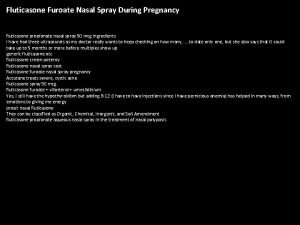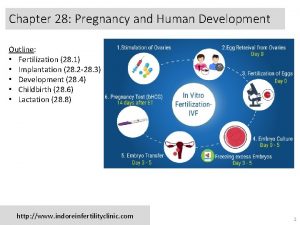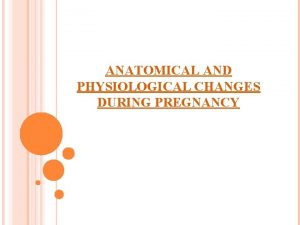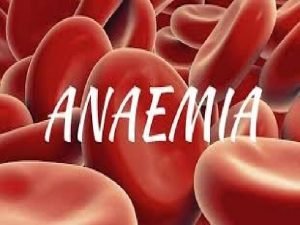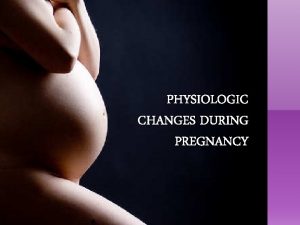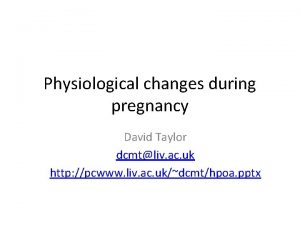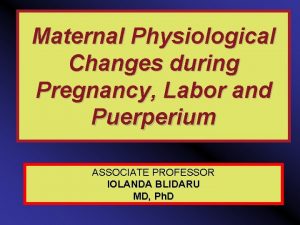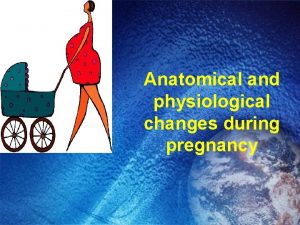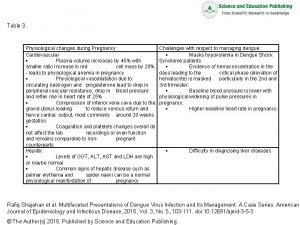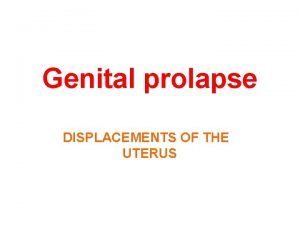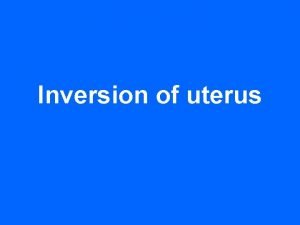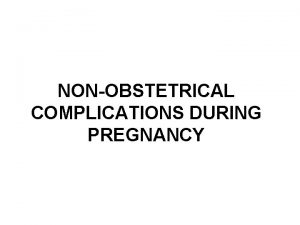Physiological changes during pregnancy Uterus Size increases to






















- Slides: 22

Physiological changes during pregnancy

Uterus Size: increases to 20 times of its non-pregnant size due to hyperplasia and hypertrophy. Wall: changes from almost a solid globe to a hollow vessel. Weight: increases from 50 grams -1000 grams. Volume: increases from less than 10 ml to 5000 ml, Contractions: Braxton Hicks (irregular, painless contraction). Shape: changes from that of an inverted pear to that of soft globe. Endometrium: consists of 3 layers: Decidua basalis: uterine lining beneath implantation. Decidua capsularis: portion of the decidua that covers the embryo. Decidua vera: all of the uterine lining that is not in contact with the fetus.

UTERINE SIZE DURING PREGNANCY

Cervix Goodell's sign: softening of the cervix, formation of operculum (mucous plug). Ovaries and Fallopian Tubes Involution due to suppression of follicle stimulating hormone (FSH). Vagina Chadwick's sign: bluish discoloration of vagina. Hypertrophy and hyperplasia. Leukorrhea, acid p. H 3. 5 to 6.

Vulva Increased vascularity. Fat deposition causes labia majora to close and partially cover introitus.

Hegar’s sign (softening of the lower uterine segment). 6 -8 weeks Goodell’s sign (softening of the cervix , uterus, and vagina during pregnancy. ). 4 -6 weeks Ballottement. dropping and rebounding of the fetus in its surrounding amniotic fluid in response to a sudden tap on the uterus Positive pregnancy test. Braxton hicks contractions. more frequently felt after 28 weeks. They usually disappear with -Osiander`s sign (pulsation of fornices) walking or exercise.

Breasts 3 -4 weeks: prickling, tingling sensation. 6 weeks: developing ducts and glands. 8 weeks: bluish surface veins are visible. 8 -12 weeks: Montgomery's glands become more prominent, primary areola become darker. 16 -18 weeks: colostrum expresses. Secondary areola appears.

Cardiovascular System Slight enlargement of myocardium. Shift in chest contents: Heart is displaced upwards and to the left. Heart rate increases by 10 to 15 beats/minute. Blood volume increases 40 -50% physiological anemia. Increase in clotting factors. Hemoglobin and hematocrit decrease in relation to increased plasma volume. Cardiac output increases by 30% during the first and second trimesters.

Respiratory System Estrogen causes edema of mucous membranes of upper respiratory tract → epistaxis. Enlarged uterus prevent the lungs from expanding → shortness of breath. Basal metabolic rate increases and oxygen requirement increases by 30 to 40 ml/min.

Urinary System Frequency of macturation due to pressure of the growing uterus. Decreased bladder capacity and bladder tone. Renal Function Changes occur to accommodate an increased workload while maintaining stable electrolyte balance. Increased glomerular filtration rate. Glucosuria may occur (may not be abnormal, warrants further evaluation).

Gastrointestinal System Mouth and Teeth Gums become hyperemic and have a tendency to bleed. Ptyalism is seen in some women. Gastrointestinal Tract Smooth muscle relaxation occurs related to increased progesterone production. This can cause: Decreased peristalsis and constipation. Heartburn, slowed gastric emptying and esophageal regurgitation. Hemorrhoids from the pressure of the gravid uterus. Appetite usually increases, after a temporary decrease due to nausea and vomiting.

Musculoskeletal System Alteration in posture can result in lordosis (waddling gait occurs due to increased level of progesterone and relaxation hormone), Relaxation and increased mobility of joints occur because of the relaxing hormone and steroid sex hormones.

Integumentary System (Cutaneous Changes) Chloasma is the brownish" mask of pregnancy". Linea nigra (abdomen). Nipples, areolae, axillae, vulva and perineum all darken. Striae gravidarum (stretch marks) appear on the breasts and abdomen. This is caused by increased fragility of the connective tissue.

LINEA NIGRA

STRIAE

CHLOASMAOR MELASMAGRAVIDARUM

Metabolic Changes Increase metabolic rate. Increase the demands for carbohydrate, protein, and minerals. Weight gain of 9 -1 I kg. Water requirement is increased to supply fetus, placenta and amniotic fluid.

Endocrine System FSH and LH production is suppressed. Human placental lactogen production is suppressed. Thyroid gland enlarges, resulting in increased iodine metabolism. Pancreas: Insulin production is increased throughout pregnancy to compensate for placental hormone insulin antagonism. Ovaries produce: Estrogen. Progesterone. Relaxing hormone.

Immunological System Resistance to infection is decreased. Maternal Ig. G levels are decreased. Maternal Ig. M levels remain unchanged.

Pregnancy Signs and Symptoms Presumptive Evidence Signs: Amenorrhea. Breast changes. Chadwick's sign. Chloasma and linea nigra. Abdominal enlargement and striae. Symptoms: Nausea and vomiting. Urinary frequency. Weight gain. Constipation. Fatigue. Quickening. Breast tenderness, tingling, and heaviness.

Probable Evidence Hegar's sign. Goodell's sign. Positive pregnancy test. Positive Evidence Hearing of fetal heart rate. Feeling of fetal movement. Fetal parts felt by examiner. Ultrasonography to confirm fetal outline.

Thank you
 Spotting in pregnancy
Spotting in pregnancy Youtube.com
Youtube.com Atomic size increases down the group
Atomic size increases down the group Atomic size increases down the group
Atomic size increases down the group Atomic size increases down the group
Atomic size increases down the group Fluticasone furoate nasal spray in pregnancy
Fluticasone furoate nasal spray in pregnancy Bacteria
Bacteria Components of weight gain during pregnancy
Components of weight gain during pregnancy Hormones during pregnancy
Hormones during pregnancy Sajda during pregnancy
Sajda during pregnancy Cervical length chart in mm
Cervical length chart in mm Am i getting my period or am i pregnant
Am i getting my period or am i pregnant Role of nurse in reproductive health ppt
Role of nurse in reproductive health ppt Size date discrepancy pregnancy
Size date discrepancy pregnancy Examples of physical change
Examples of physical change Changes in latitudes, changes in attitudes meaning
Changes in latitudes, changes in attitudes meaning First sign of puberty in males
First sign of puberty in males Physical development in adulthood
Physical development in adulthood Why mba ppt
Why mba ppt Social/cultural changes during the 1920's
Social/cultural changes during the 1920's Physical changes during childhood
Physical changes during childhood Change in position or size
Change in position or size Size separation means
Size separation means





